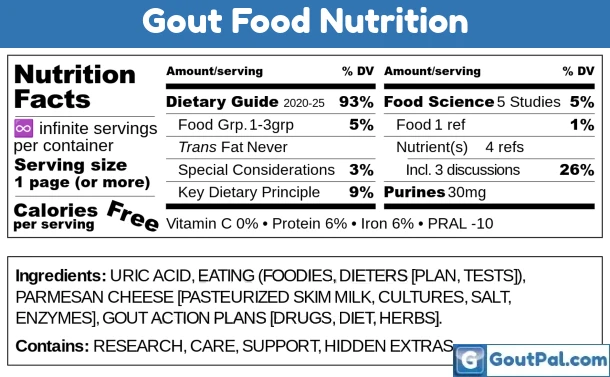Gout Nutrition Facts
Is your food good or bad for gout? Start with these gout nutrition facts.

Gout Nutrition Facts Introduction
You want to know which food is good or bad for gout. But what about other diseases and your general wellbeing? Get gout nutrition facts to ensure your eating pattern covers all you need. And help your gout in the process.Gout Nutrition Facts Purpose
I wrote this to help GoutPal Foodies and GoutPal Dieters understand their food choices. Because that helps you discuss your dietary requirements with health advisers.Gout Nutrition Facts
Every day, gout sufferers ask, "is food good or bad for gout". Where "food" can be replaced by just about anything we eat or drink. But gout, or more specifically uric acid, changes according to our total food intake. Not one individual food item. So my approach is to explain the nutrition facts about the food in question. Then you can compare that food to alternatives. In that way, the question becomes "is 'food a' better than 'food b' for lowering uric acid".Unfortunately, there is little help from professional gout guidelines for anyone wanting to improve their lifestyle. Because the small section of the rheumatology guideline only has conditional recommendations to limit alcohol, purine, and high-fructose corn syrup intake. One more conditional recommendation is weight loss for patients who are overweight or obese. Finally, they conditionally recommend against vitamin C supplementation (for the purpose of treating gout). With the explanation that Dietary modifications likely yield only small changes in SU [serum urate] concentration[1]
So for each food, I collect facts about nutrients that might affect uric acid or inflammation. Together with any scientific studies about the food's effect on gout.
Dietary Guidelines Nutrition Facts
Whatever the scientific studies say about individual foods, it is vital that your eating patterns provide all the balanced nutrition that you need. Hence, I base most of my nutrition facts on the Dietary Guidelines for Americans (DGA)[1] and associated USDA nutrition databases. Describing food groups, weekly or daily allowances, and optional Special Considerations:DGA Food Group
Identifying the DGA Food Group for each food that concerns you is a good first step. Because it allows you to see what part that food plays. So that you can find appropriate alternatives.Weekly/Daily Allowance
For each food group, DGA lists daily or weekly amounts of food for your situation. Based on age, gender, and preferred eating style. I use a 2,000-calorie Mediterranean-Style Dietary Pattern as an example. But you need to see what your needs are. This gives you a context for individual foods that allows you to make better choices. E.g., if you're asking about chicken, you can judge it against your allowance for `Meat, Poultry, & Eggs`. Which for my eating pattern is 26 oz per week. However, I would not eat the full group allowance of a single food item. Because a key dietary principle from the guidelines tells us that food variety gives a better balance of nutrients:CHOOSE A VARIETY OF OPTIONS FROM EACH FOOD GROUP
Enjoy different foods and beverages within each food group. This can help meet nutrient needs
Special Considerations
Where the guidelines include special considerations for certain foods or groups, I include this in the food nutrition facts. E.g., for chicken:Most intake of meats and poultry should be from fresh, frozen, or canned, and in lean forms (e.g., chicken breast or ground turkey) versus processed meats (e.g., hot dogs, sausages, ham, luncheon meats).
Food & Nutrition Science
I include any studies about the food affecting uric acid or gout pain. Also, I include data about nutrients that affect uric acid:
- purines
- vitamin C
- iron
- protein
- PRAL
- beta-carotene
- vitamin A
- quercetin
- anthocyanins
- luteolin
I'm currently investigating micronutrients with a view to updating some of those food lists and adding new ones. So please see the feedback link below to check my progress on these planned updates.

Your Gout Nutrition Facts
You have learned how and why I present gout nutrition facts. So now it's time to assess what you eat. Then see if there are better food choices that you can enjoy.To find information about foods that concern you, type the name of the food or drink into Google Gout Search Engine.
If you still have concerns about gout nutrition, you should discuss those concerns with your professional health advisers. However, if you want help to prepare for that discussion, please see the feedback section below.
Leave Gout Nutrition Facts to browse the Gout and Uric Acid Blog.
Gout Nutrition Facts Feedback
Please share your thoughts about this page. To discuss other gout concerns, use the feedback link for the most relevant page. But if you just want to chat with other gout sufferers about gout nutrition, use GoutPal's Gout Discussions.
If you are asking a question, it's best to:
- Search for that question in Google Gout Search Engine first.
- Choose the most relevant result.
- Refer to that result as you ask your question.
Gout Nutrition Facts References
- FitzGerald, J.D., Dalbeth, N., Mikuls, T., Brignardello‐Petersen, R., Guyatt, G., Abeles, A.M., Gelber, A.C., Harrold, L.R., Khanna, D., King, C. and Levy, G., 2020. 2020 American College of Rheumatology guideline for the management of gout. Arthritis care & research, 72(6), pp.744-760.
- U.S. Department of Agriculture and U.S. Department of Health and Human Services. December 2020. Dietary Guidelines for Americans, 2020-2025. 9th Edition.
